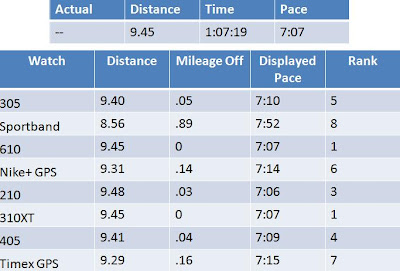- Garmin Forerunner 305
- Garmin Forerunner 405
- Garmin Forerunner 210
- Garmin Forerunner 310XT
- Garmin Forerunner 610
- Timex Ironman GPS
- Nike+ Sportwatch GPS
- Nike+ Sportband (just for fun)
- Track workout consisting of 6x800m sprints with 400m jog rest
- Trail run consisting of a 2.2 mile loop 3 times
- Road run of 9.45 miles around White Rock Lake
Run #1: Track
I took all 8 watches to the track for some 800m repeats. I stayed in lane one on the inside of the lane the whole time so I wouldn't stray from exactly .25 miles each lap. With the 400m recovery after each repeat, the total mileage for the run was 4.50 miles. Here are the results from the workout:
So the total workout took me 29:32 for the 6 800's and the recovery jog. I didn't do splits for the run because that would have been way too hard to press the lap button on all those watches. But as you can see, the Nike+ GPS is the clear winner for sure. It was spot on for the whole workout. I am very impressed with Nike on the track. Both of their watches ranked in the top 3. As long as you have the Sportband calibrated properly, it can hang in there with the expensive watches. I threw in the column for displayed pace to show how much of a difference .05 of a mile makes even in a short run like this one. So from the best of the watches closing in at .01 miles off to the worst watch at .27 miles off, GPS has a long way to go for track workouts. Kings of the Track:
- Nike+ Sportwatch GPS
- Garmin Forerunner 305
- Timex Ironman GPS
The reason GPS watches have such a hard time with distance on the track is the constant turning. Because the watch gets signals from the satellites every 3-6 seconds, the watch connects the points linearly instead of on a curve. When you think about it logically, however, the GPS path should be shorter instead of longer. It could be that the watch is trying to accommodate for the curve and adding extra distance, or it could be that people actually don't run on the 400m section of the track, they could waver a little bit and go into other lanes or not take the innermost section of the track.
Run #2: Trail
Depending on the trail, GPS watches have never really been the best in tracking distance. Elevation changes, switchbacks, and tree cover all make pinpointing a location very hard. Often you will see watches that are way off in distance both above and below the actual distance. So I hit the trail on a 2.2 mile loop that has tons of elevation change, loads of switchbacks, and about 75% tree cover. I did the loop three times to make sure I could really test to see how the watches were doing and see if they were consistent throughout the multiple laps. Here are the results from test #2:
I expected there to be a big difference amongst the watches, but I had no idea it would be this bad. The closest to being the actual distance was the 310XT and it really was the stand out in the group. The probable reason for the watches performing so poorly was the tree cover. The signal gets blocked temporarily and then the watch has to guess where you went, which means you could lose an entire switchback or a long stretch of random trail. The only watch to display a farther distance than actual was the Sportband, and that makes perfect sense. The Sportband goes based off number of footstrikes, not GPS location. Since you take smaller steps when you are trail running, and your watch is calibrated for your typical longer stride, it thinks you are going further than you actually are. Kings of the Trail:
 |
| Aerial view of the trail run |
- Garmin Forerunner 310XT
- Garmin Forerunner 610
- Garmin Forerunner 305/Nike+ Sportband
Run #3: Road
Your typical runner is going to be running primarily on the roads, which is why this test was so important. I went and did a lap around a lake, which is typically 9.3 miles, but I took a wrong turn and it added .15 miles. So I did a 9.45 mile run on the road in a completely open area with no tree cover. I expected to get the most accurate results here and the tightest span from worst to best. Here are the results:
Between the GPS watches, the span wasn't too bad. The worst was only .16 off, which isn't horrible over the course of 9.45 miles. The Sportband obviously wasn't calibrated correctly for this run, so it performed the worst of all of them. The 610 and 310XT were exactly correct which is very impressive by both watches! Looking at these results though, you can obviously tell Garmin is king of the road. Official Kings:
- Garmin Forerunner 610/310XT
- Garmin Forerunner 210
- Garmin Forerunner 405
Overall Results
When we go based just off the average percent error of all 8 watches, here is the order of most to least accurate in varying conditions:
- Garmin Forerunner 310XT
- Garmin Forerunner 610
- Garmin Forerunner 305
- Garmin Forerunner 405
- Garmin Forerunner 210
- Nike+ Sportwatch GPS
- Timex Ironman GPS
- Nike+ Sportband
Overall, very interesting results coming from these tests, I never would have expected what came about. I will leave you with my GPS watch accolades:
- Best GPS Watch Overall: Garmin Forerunner 310XT
- Best GPS Watch for Track Running: Nike+ Sportwatch GPS
- Best GPS Watch for Trail Running: Garmin Forerunner 310XT
- Best GPS Watch for Road Running: Garmin Forerunner 310XT and Garmin Forerunner 610
- Best Value GPS Watch Based on Accuracy: Garmin Forerunner 305





















